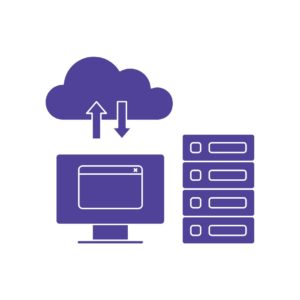Sales represent a real challenge in terms of maintaining the performance of your e-shop. Traffic spikes can put a strain on your site. How can you manage the influx of visitors, anticipate the scale of traffic and maintain a good page loading time? What tools should you use to evaluate and improve your performance? Our experts give you their advice to approach this period with peace of mind.
Anticipate traffic peaks on your website
Launch of advertising campaigns
When you launch an advertising campaign, create viral content, increase your media budget or offer attractive promotions, you can expect a sudden increase in the number of simultaneous visitors to your e-shop. This spike, measured against the usual average number of visits, is a good indicator of the attractiveness of your offer, but it can cause technical problems if not well managed.
Seasonal peaks
Spikes can also be due to seasonality within your industry, such as typically during sales. Traffic analysis tools such as Google Analytics, Google Search Console, Semrush or Matomo can provide valuable information on traffic volume, traffic sources and visitor behavior throughout the year. This historical data will help you anticipate seasonal traffic spikes and risky periods, understand their causes and plan your strategies to manage them effectively.
Peaks in interactions and requests
It’s also crucial to understand that spikes aren’t just related to an increase in visitors, but also to an increase in interactions and requests on your site. These could be link clicks, cart additions, or page loads. These things contribute to the overall load on your site’s servers, potentially affecting its performance and availability.
Know the capabilities of your site
Knowing your site’s ability to handle a high traffic load is essential. This involves having a good understanding of your site’s technical architecture, the availability of your servers, and their ability to handle a large number of simultaneous requests. Being well prepared can help you avoid your site becoming unavailable or very slow during a traffic spike.
The consequences of a poorly managed traffic peak
Impact on site performance
One of the major consequences is the deterioration of loading speed. A sudden and massive influx of visitors can overload the servers, slowing down the response time of the site. In addition, the number of simultaneous requests can increase exponentially, testing the capacity of your infrastructure to handle these requests.
In the worst case scenario, a site can become completely unavailable, unable to handle the sudden traffic load. This can result in pages not loading, interrupted transactions or features ceasing to function.
Influence on user experience
User experience is directly impacted by how your site responds to traffic spikes. A slow or unavailable website can frustrate users, causing them to abandon their purchases or look for alternatives. This can have a significant impact on user satisfaction and their willingness to return to your site in the future.
Impact on the conversion rate
These technical issues can have direct implications on your conversion rate. Indeed, a slow or unavailable site does not allow visitors to complete their purchases, which can lead to a significant drop in your sales. A poor user experience can also dissuade visitors from finalizing their purchase, thus reducing the number of conversions despite high traffic.
According to several studies, a difference of just one second can lead to a 7% reduction in conversions.
Effect on brand reputation
A poorly managed traffic spike can tarnish your brand image in the eyes of consumers. An inaccessible or slow website can come across as unprofessional and unreliable, causing customers to lose trust in your brand. Additionally, technical issues can hurt your business’ credibility, especially if dissatisfied customers share their negative experiences online.
Data loss due to your CMP limitations
During peak traffic periods, it is crucial to be mindful of the data limits imposed by your Consent Management Platform (CMP) used for Consent Mode. Depending on the solution chosen, there may be restrictions on the number of users or page views that can be processed simultaneously. If these limits are exceeded, there is a risk of losing valuable data related to user consent tracking. Make sure you are aware of these limits and closely monitor the usage of your CMP during peak traffic periods. By anticipating these constraints and adjusting your settings accordingly, you can ensure the preservation of your tracking data and maintain compliance with data protection regulations.
Prepare your technical infrastructure
Designing resilient architecture
To ensure your site’s resilience to traffic spikes, a well-thought-out architecture is essential. Here are some key steps to achieve this:
-
Code and resource optimization
- Reduce server response times: Make sure your site code is optimized. Heavy scripts and unoptimized images can slow down your site.
- Asset Minification: Code minification is the process of reducing the size of code by removing unnecessary whitespace, comments, and other non-essential elements.
- Modern Image Formats: Use modern and responsive image formats to improve loading performance.
-
Cache system
- Using a Cache System: Significantly reduces the load on servers by storing static versions of frequently requested pages.
- Static Resource Caching: Enable caching on your web server for elements that don’t change often, such as images, CSS, JavaScript, and HTML pages. This stores these files in the user’s browser cache, preventing them from being re-downloaded on each visit and improving the loading speed of your site.
-
Load balancing and CDN
- Load Balancing: Distribute the load across multiple servers or instances to reduce the risk of failures. Load balancing distributes incoming traffic evenly across multiple servers, preventing a single server from becoming overloaded and improving the availability and reliability of your site.
- Content Delivery Network (CDN): Use a CDN to distribute the load and improve load times for static content. A CDN works by storing copies of your content on servers in various geographical locations. This reduces the distance between the server and the user, speeding up content delivery and improving the overall user experience.
-
Load and scalability testing
- Load simulations: Run simulations to assess the capacity of your infrastructure. Test various scenarios to identify the limits of existing systems.
- Scalable solutions: Make sure your hosting provider offers scalable solutions. Cloud hosting is often more flexible and scalable than traditional solutions.
-
Protection against DDoS attacks
- DDoS Protection Services: Use the DDoS protection services offered by major hosting providers like Microsoft Azure, Amazon Web Services (AWS) or OVHcloud. These services will help you effectively protect yourself against attacks that attempt to overload your server with malicious requests.
- Security Tools: It is possible to set up a Web Application Firewall (WAF) to protect your site against threats. For example, a WAF can detect suspicious connection attempts. Then, tools like Fail2Ban, CrowdSec or SSHGuard analyze the WAF logs to identify malicious IP addresses. If an IP address makes several failed attempts, these tools can ban it by adding it to a firewall, thus blocking access.
-
Real-time monitoring
- Monitoring tools: Implement real-time monitoring tools to quickly detect anomalies and intervene before problems become critical. We will expand on this later in this article.
L’hébergement : la clé de vos performances

Pour qu’il puisse répondre aux exigences croissantes, il est possible de rendre l’hébergement flexible afin qu’il s’adapte aux charges spécifiques à un moment donné. Grâce à la virtualisation, à la containerisation et à un bon orchestrateur, il est possible d’ajuster les performances de l’hébergement en fonction des besoins. Par exemple, avez-vous besoin de la puissance maximale pendant la nuit lorsque tout le monde dort ? Un serveur agile permet d’ajouter ou de réduire les ressources nécessaires. Cela contribue non seulement à réduire les coûts, mais aussi à résister à un afflux important de visiteurs lors d’un événement.

Choose a high-performance host
Select a hosting provider that is known for its reliability and ability to handle significant traffic spikes. Opt for solutions that offer 24/7 availability and technical support guarantees.
Opt for Cloud hosting
Cloud hosting is often more flexible and scalable than traditional solutions. It allows resources to be adjusted quickly according to needs, thus ensuring better management of traffic peaks.
Schedule regular updates and testing
Perform regular updates to your site and servers to avoid security breaches and performance issues. Test your site regularly to ensure it can handle a sudden increase in traffic.

Monitor your traffic and KPIs
What tools should you use to analyze your site traffic?
To analyze your site’s traffic, several powerful tools are available. Among the most used, Google Analytics stands out by offering an overview of traffic in real time, the sources of this traffic and the most visited pages. In addition, tools like Semrush and Similarweb provide similar features, with in addition a detailed SEO analysis and reports on the site’s performance.
Regularly monitoring the number of active visitors allows you to quickly identify potential problems. Analyzing user behavior is also crucial to understand how they interact with your site, which pages they visit and how they access them. This information is essential to optimize the user experience and improve the overall performance of your site.
What tools should you use to analyze your infrastructure?
To monitor the health of your infrastructure and manage traffic spikes effectively, it is essential to use robust monitoring tools. Some of the most commonly used tools include New Relic, Datadog, Prometheus, and Grafana. These tools are widely adopted for their efficiency and advanced features.
Using these tools allows you to measure the performance of your site using key indicators. This allows you to evaluate the speed of your site and its efficiency in responding to user requests. By having real-time visibility into the health of your infrastructure, you are better prepared to anticipate and manage traffic spikes, thus ensuring an optimal user experience.
How to Track Your Core Web Vitals (For Free)?
Other KPIs to monitor are Core Web Vitals and Time to First Byte (TTFB). These are essential indicators for assessing the quality of the user experience on your site. Core Web Vitals include Largest Contentful Paint (LCP), First Input Delay (FID), and Cumulative Layout Shift (CLS). You can analyze these by creating your own Looker Studio dashboard via this link.
Adapt quickly in the event of a peak
Even with maximum planning for traffic peaks, a larger than expected influx can occur. To ensure that this success does not turn into a disaster, it is crucial to integrate a decisive aspect into your hosting strategy: flexibility.
Choose flexible resources
Cloud solutions from providers such as Azure, AWS, or Google Cloud play a key role in dynamically adapting resources to changing needs. These platforms allow you to:
- Scale up capacity on demand: You can quickly add virtual servers (VMs) or increase the capacity of existing servers to handle increased traffic.
- Automatic scaling: Use auto-scaling features to automatically adjust your infrastructure to increase or decrease load.
Increase your resources when needed
Cloud solutions from providers such as Azure, AWS, or Google Cloud play a key role in dynamically adapting resources to changing needs. These platforms allow you to:
- Scale up capacity on demand: You can quickly add virtual servers (VMs) or increase the capacity of existing servers to handle increased traffic.
- Automatic scaling: Use auto-scaling features to automatically adjust your infrastructure to increase or decrease load.
Implement crowd control solutions
To avoid overload and ensure a smooth user experience, implement mechanisms to regulate the massive influx of visitors:
- Virtual queues: Use queuing systems to manage the influx of visitors during peak periods, allowing gradual access to the site.
- CDN (Content Delivery Network): Distribute content from servers close to users to reduce the load on your main server and improve loading times.
- Load Balancing: Distribute the load between multiple servers to avoid any one of them being overloaded.
By incorporating these strategies, you will be better prepared to handle unexpected traffic spikes and maintain optimal performance for your e-shop, even during peak periods.
Conclusion
Managing traffic spikes on your e-shop requires careful preparation and a robust technical infrastructure. By anticipating traffic spikes, optimizing your site and monitoring its performance in real time, you can ensure a smooth user experience and maintain your conversion rates, even during peak periods. The key is to be well prepared and be more responsive to face the challenges posed by traffic spikes. Adopt flexible and scalable solutions, and make sure you have mechanisms in place to regulate and manage the influx of visitors effectively.

Meticulous and perfectionist, Céline specializes in the creation of SEO-oriented content. But these are not her only assets! She also puts her creativity at the service of our Social Media Strategy team to create ultra-targeted campaigns designed to convince and convert.



